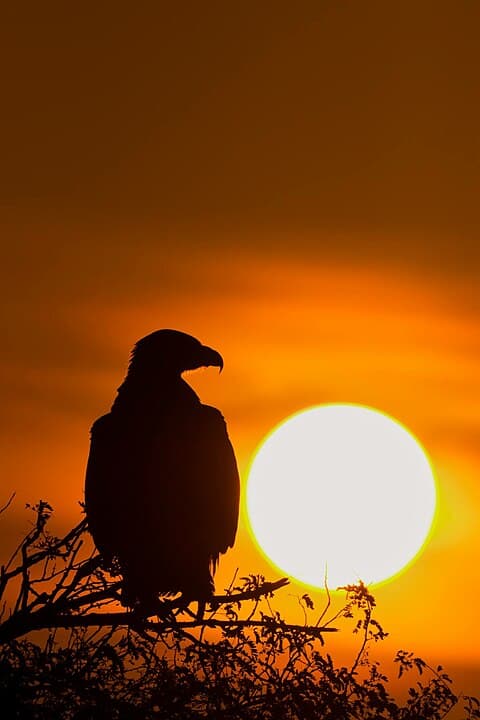Though not native, there are 6 eagle species in Cambodia and I am excited to know that. I do not know where they actually live in here but the eagles you will see below have been spotted by people. I asked my dad if we have eagles in Cambodia because they are not common birds here. He said he knew someone who shot an eagle during the Khmer Rouge Regime without knowing it was an eagle at the time. Maybe they live in mountainous areas that are secluded from humans, so let’s find out the 6 eagle species in Cambodia below.
Black Eagle (ឥន្រ្ទីខ្មៅភ្នំ)
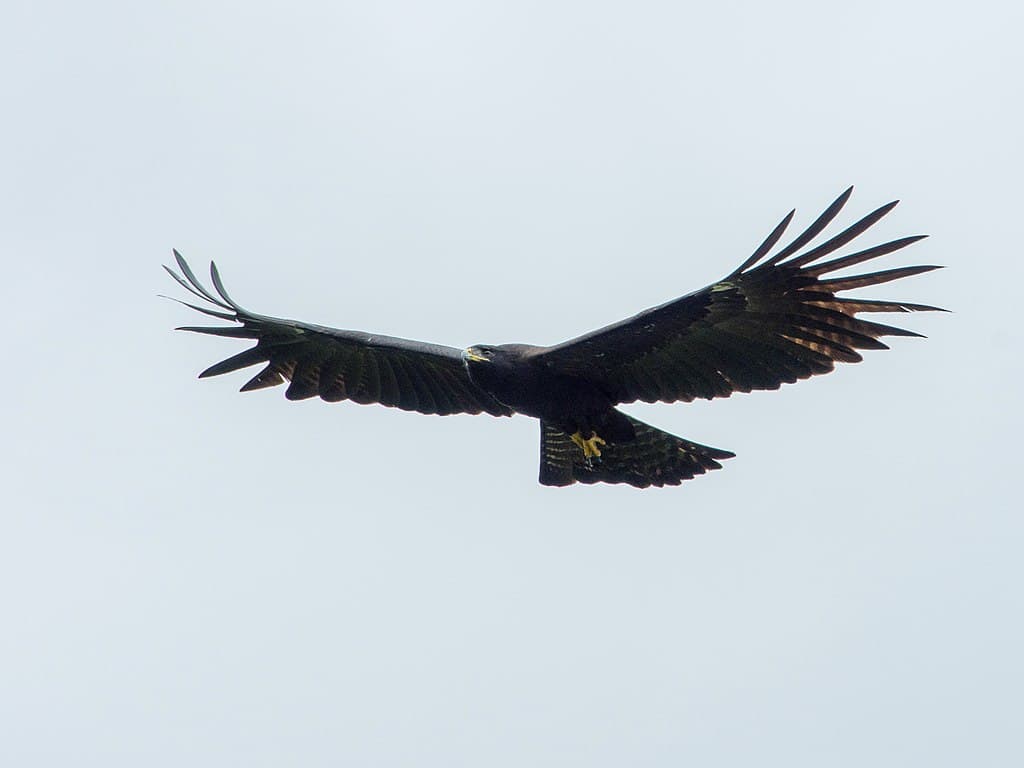
A black eagle is large yet slender, measuring around 75 centimeters in length with a wingspan of 148 to 182 centimeters. When it flight, the most distinctive feature of these birds is the “fingers” from their feathers. Adult black eagles have all-black plumage and talons with a yellow bill base and feet; hence the name. They have curved claws with wide gape that allow them to pick up eggs and snatch birds in flight. Their long wings and tail make them very agile when flying, both when displaying and hunting.
Not to be confused with the Verreaux’s eagle (Aquila verreauxii) which is also called the black eagle, this one is different. This black eagle (Ictinaetus malaiensis) is the bird of prey that lives across South Asia and Southeast Asia. These fierce birds live in hilly regions of subtropical and tropical forests where they hunt birds and mammals. This eagle species also frequent lowland and montane forests, and forests with good forest cover on mountainous country and slopes. Some of their common meals are mammals such as amphibians, bats, insects, macaques, reptiles, and squirrels. The interesting thing is that they raid bird nests to feed on the residents. Deforestation is one of the threats to their population but their global population is doing well at the moment.
Booted Eagle (ឥន្រ្ទីតូច)
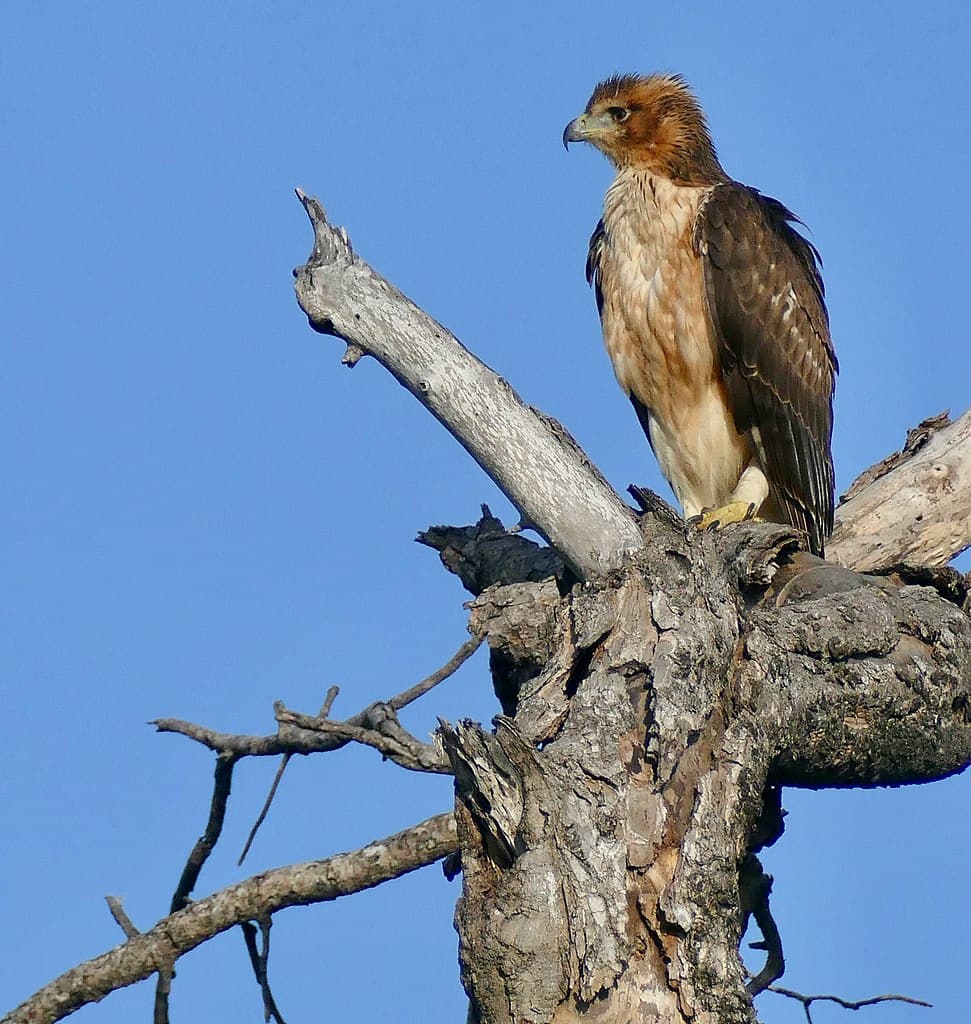
This is a small eagle species at a size of only around 40 centimeters with 110 to 132 centimeters wingspan. The unique thing about them is that there are two plumage forms: mid-brown plumage and pale plumage. Mid-brown plumage birds have dark gray flight feathers while the pale birds are mainly light gray with darker flight feathers and heads. However, both forms have lighter brownish coverts that fade to a paler almost white at the tips. The upper tail coverts are also pale brown while their tails are almost white and appear as translucent.
When it comes to distribution, booted eagles have a wide one across Africa, Asia, and Europe. Their favorite habitats are hilly countryside with some open areas and wooded areas and they breed in rocky broken terrain. Some of the Palearctic breeding population also nest in coniferous or deciduous woodlands and often in trees. This raptor hunts birds, reptiles, rodents, and small mammals by gliding and slow soaring over forest edges and slopes. Once it spots prey, it will stoop down to snatch it. Though healthy, their population is under some threats from habitat destruction and more open landscapes for hunting.
Eastern Imperial Eagle (ឥន្រ្ទីកញ្ចឹងកស)
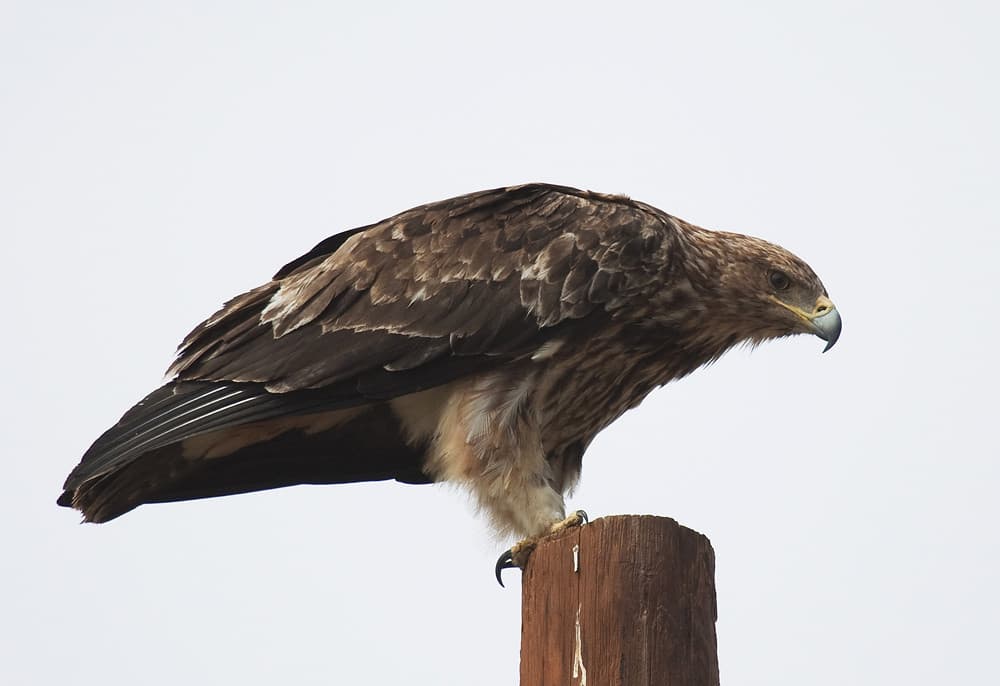
Here you are looking at a large bird of prey that measures up to 90 centimeters with a wingspan of 1.76 to 2.2 meters. Adult eastern imperial eagles have a tar-like blackish-brown plumage with creamy to golden buff crown, hindneck, and neck sides. Their tails have narrow dark bars over a grayish ground color with a broad black subterminal band. This bird has a relatively long and thick neck as well as a big head and bill.
As migratory birds, the range of this raptor extends through Asia including Central, East, and South Asia. Across their range, they are fond of open country with scattered trees or more enclosed woodlands, and habitats around or near wetlands. These raptors forage in agricultural areas, grasslands, and open areas while their breeding range is very wide. And when it comes to the hunting skills, they are totally one of a kind. Eastern imperial eagles hunt both in flight and on the ground, with a large variety of meals. They hunt fish, ground squirrels, hares, insects, invertebrates, reptiles, and rodents as well as fledgling birds and water birds. These eagles either hunt alone or with a partner, and sometimes they also steal food from other raptors.
This eagle species is classified as Vulnerable on the IUCN Red List since 1994 due to habitat loss and prey. Besides these, their other threats are accidental exposure to pest control chemicals for rodents, electrocution on power poles, and illegal poisoning.
Greater Spotted Eagle (ឥន្រ្ទីខ្មៅវាល)

Greater spotted eagles have a black-brown body, measuring from 59 to 74 centimeters and a wingspan of 1.60 to 1.83 meters. It has a short neck with a large shaggy-naped head that looks like a bad hairdo. The wings of the bird are so broad and long that they reach the short and round tail tip. As hunters, they have large feet with talons that make snatching prey an easy job. Juveniles have an extremely elegant look of black-brown with whitish yellowish drop-shaped spots.
This eagle species live in forest edges and open wet forests near bogs, floodplain forests, marshes, swampy patches, and wet meadows. These eagles perch in the open, mostly on treetops at a forest edge as well as bush, steep riverbanks, and utility poles. While many eagle species are hunters, this one is more of a forager and scavenger; especially in winter. It scavenges carrion but it also hunts frogs, reptiles, rodents, small birds, and small mammals over marshes or wet fields. Despite a wide range, greater spotted eagles are considered Vulnerable to Extinction on the IUCN Red List. The two main threats are habitat degradation and habitat loss due to drainage of wetlands and intensified agricultural practices.
Indian Spotted Eagle (ឥន្រ្ទីត្នោតចាស់)
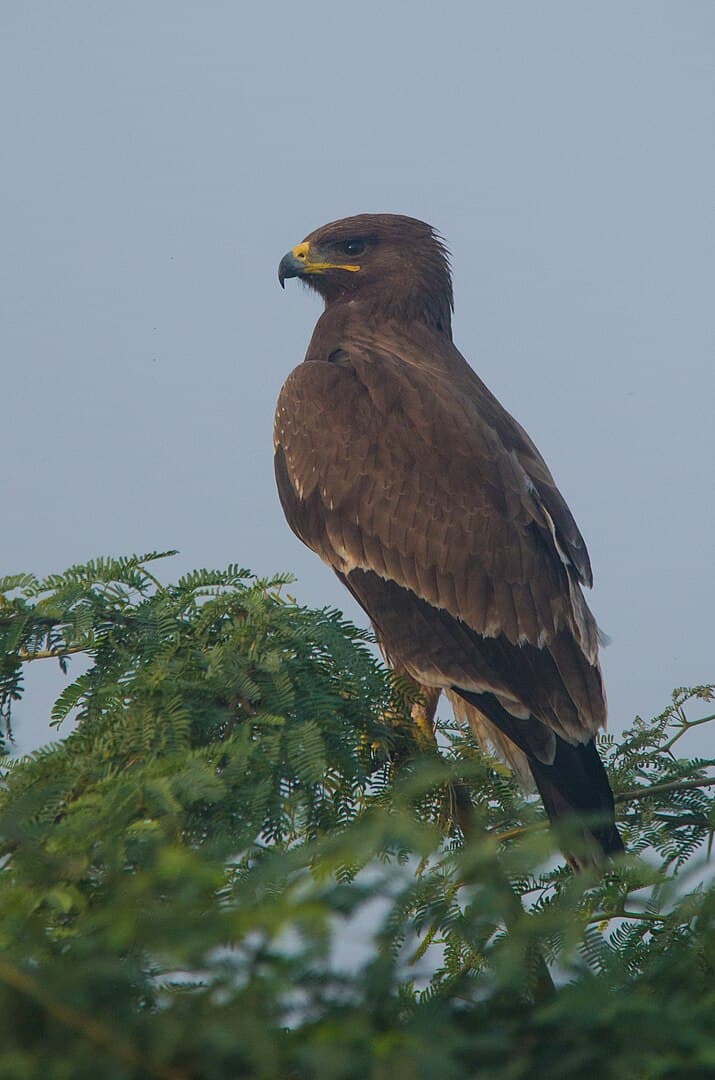
Growing to around 60 centimeters with a wingspan of 150 centimeters, the Indian spotted eagle is a medium-sized raptor in Asia. Despite the size, it still looks pretty intimidating with its broad head, piercing eyes, pointy beaks, and sharp talons. In fact, this eagle species has the widest mouth out of all spotted eagle species. An Indian spotted eagle has pale brown plumage with pale spots while the iris is very dark in color.
Though native to South Asia, Indian spotted eagles also live in some countries across Southeast Asia including Cambodia and Myanmar. Their common habitats are agricultural landscapes and tropical dry forests where they hunt amphibians, fish, insects, reptiles, rodents, small birds, and small mammals. At the same time, they also like living in grasslands, marshes, open forests, urban parks, wetlands, and woodland areas. They are classified as Vulnerable on the IUCN Red List due to some threats such as climate change and habitat destruction.
Steppe Eagle (ឥន្រ្ទីវាលក្រម៉ៅ)
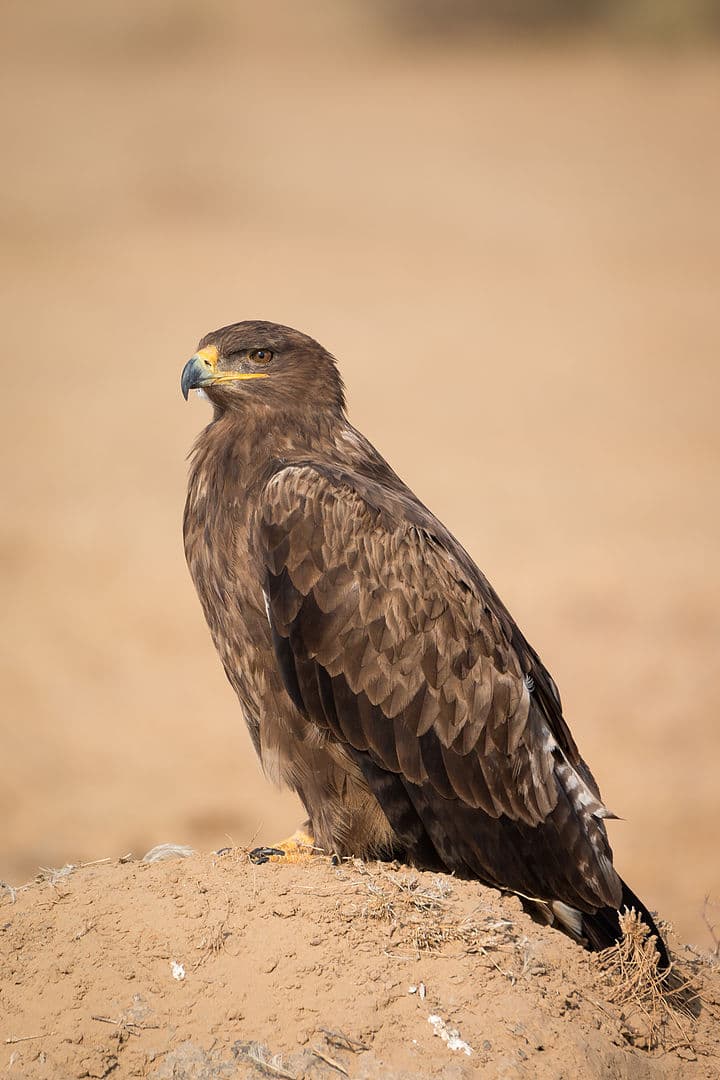
Large and bulky, a steppe eagle can grow from 60 to 89 centimeters with a wingspan of 1.65 to 1.74 meters. There are large individuals whose wingspan can be as large as 2.5 to 2.62 meters which is massive. Steppe eagles have a robust look, and it is mainly dark brown in color with very thick necks. While looking similar to many eagles out there, you can tell them apart by their broad bill and large head. Even the overall size is larger than most eagle species, and they have more conspicuous fingers a thicker neck. Not to mention the fierce expression, steppe eagles look very intimidating.
Steppe eagles are found throughout Africa, Asia, Europe, and the Middle East, living in a number of habitats. These birds inhabit agricultural fields, deserts, grasslands, open savannas, paddy fields, pastures, open woodlands, semi-desert, and steppe. They usually perch and look for prey from an upright spot such as rocks, posts, and trees. As for their nest, steppe eagles build them next to rodent colonies so that breakfast is one wing flap away. In fact, the steppe eagle is the only eagle that primarily builds its nest on the ground.
Ground squirrels fear these eagles as they are one of the top meals on the raptor’s menu. Some of their common meals are reptiles, small birds, and small mammals like gerbils, hares, hedgehogs, marmots, pikas, and voles. However, when winter comes and they become sluggish, they feed on carrion and insect swarms instead.
Related Post: Hawk-Eagle Species In Cambodia
